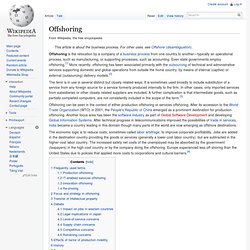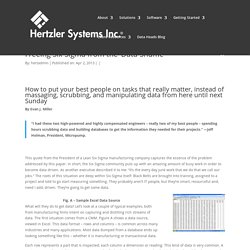

Offshoring. Offshoring is the relocation by a company of a business process from one country to another—typically an operational process, such as manufacturing, or supporting processes, such as accounting.

Even state governments employ offshoring.[1] More recently, offshoring has been associated primarily with the outsourcing of technical and administrative services supporting domestic and global operations from outside the home country, by means of internal (captive) or external (outsourcing) delivery models.[2] The term is in use in several distinct but closely related ways.
It is sometimes used broadly to include substitution of a service from any foreign source for a service formerly produced internally to the firm. In other cases, only imported services from subsidiaries or other closely related suppliers are included. A further complication is that intermediate goods, such as partially completed computers, are not consistently included in the scope of the term.[3] Frequently used terms[edit] Compare Tanzania and India, Compare prices Tanzania and India. Compare the prices of hotels and restaurants, groceries, alcohol, clothes, entertainment, and transport in Tanzania and other countries.

We compute the price levels using data from national statistical offices and international organizations. Compare prices in Tanzania and: Hotels and restaurants: India is 28% cheaper. India. Crime stats: India vs Tanzania. Definitions % of managers surveyed ranking this as a major business constraint: Crime measures the share of senior managers who ranked crime, theft, and disorder as a major or very severe constraint.

Auto theft: Number of motor vehicle thefts (car thefts) recorded by police in that country per 100,000 population. Fear of crime > Violent hate crime: Worries being subject to a physical attack because of your skin colour, ethnic origin or religion. Tanzania. Overall macroeconomic performance has been strong, with inflation declining to single digits and gross domestic product (GDP) growth projected at about 7% in the medium term. The main drivers of growth are telecommunications, transport and financial intermediation, manufacturing and construction, and trade.
Continued emphasis on sound economic management and strengthening political governance could ensure that the newly found natural gas resources will indeed play an important role in Tanzania’s socio-economic transformation over the medium term. Life in Tanzania guide.
Tuotantotalous. Lean manufacturing. Overview[edit] The difference between these two approaches is not the goal itself, but rather the prime approach to achieving it.

The implementation of smooth flow exposes quality problems that already existed, and thus waste reduction naturally happens as a consequence. The advantage claimed for this approach is that it naturally takes a system-wide perspective, whereas a waste focus sometimes wrongly assumes this perspective. A Lean Journey: No "Fat" Behavior, Please. Transforming a traditional organization to a lean organization is about creating a cultural change.

The only way to create a sustainable cultural change is to change behavior. Many lean initiatives have failed from complications in changing behavior. Bob Emiliani who has studied lean transformations and lean behaviors was the first to use the term “fat” behavior. In production environments waste is defined as actions that consume resources but do not add value to a product in the eyes of the customer. Many in the lean community are relentlessly and systematically eliminating this waste which limits business performance and threaten prosperity. The concept of “lean” behaviors is analogous to lean production. ScreenShot374.bmp (JPEG-kuva, 318×400 kuvapistettä)
Freeing Six Sigma from the ‘Data Shuffle’ How to put your best people on tasks that really matter, instead of massaging, scrubbing, and manipulating data from here until next Sunday By Evan J.

Miller “I had these two high-powered and highly compensated engineers – really two of my best people – spending hours scrubbing data and building databases to get the information they needed for their projects.” —Jeff Holman, President, Micropump. This quote from the President of a Lean Six Sigma manufacturing company captures the essence of the problem addressed by this paper. Fig. What will they do to get data? Each row represents a part that is inspected; each column a dimension or reading. The time this takes is substantial. If your company is producing a dozen products at a time, it doesn’t take long until you have somebody spending most of their time preparing reports. Another typical application comes from the electronics industry, but the same principles apply in other examples – web traffic analysis for example.
McKinsey 7S Framework. Visual representation of the model The McKinsey 7S Framework is a management model developed by well-known business consultants Robert H. Waterman, Jr. and Tom Peters (who also developed the MBWA-- "Management By Walking Around" motif, and authored In Search of Excellence) in the 1980s. This was a strategic vision for groups, to include businesses, business units, and teams.
The 7S are structure, strategy, systems, skills, style, staff and shared values. The model is most often used as a tool to assess and monitor changes in the internal situation of an organization. The model is based on the theory that, for an organization to perform well, these seven elements need to be aligned and mutually reinforcing. Objective[edit] The eight functions of a business enterprise.